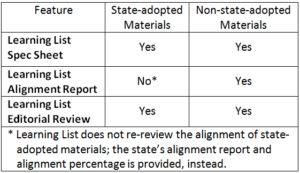As the school year shifts into high gear, we are getting a lot of questions about our service. Here are answers to the most frequently asked questions.
What is Learning List?Learning List is a subscription-based instructional materials review service designed to help improve student learning by empowering educators to choose and use instructional materials most effectively.
We created Learning List in 2013 to help districts become better informed consumers of instructional materials. Initially, districts used our reviews to facilitate their selection of materials. Over time, subscribers began telling us that our reviews also helped them identify the best parts of their existing materials to use to teach each standard. As one instructional coach explained, “We use your alignment reports as a GPS through our materials to ensure that we’re using the pages that teach each standard fully.”
What types of materials do you review?
We have reviewed over 2500 of the most widely used instructional materials, including:
- Materials in the four core subjects, 12 Advanced Placement courses, Tech Apps and 85 CTE courses;
- Comprehensive and supplemental materials, including RtI, testprep, criterion-referenced test banks, and professional development resources;
- Publisher produced and free open educational resources (OERs);
- State-adopted and non-adopted materials (i.e., materials that were not submitted for state adoption); and
- English and Spanish versions of materials.
Subscribing districts get access to all published reviews and may request reviews of additional materials as part of the subscription. That’s why Learning List is a service, not just a website.
Read more



 module, a chapter, or a 15-minute video. Both types of citations have their merits; broader citations are most likely to incorporate all of the knowledge and skills dense standards require; narrow citations can be useful instructionally, because they pinpoint more precisely where certain content or a skill is addressed in the text. [
module, a chapter, or a 15-minute video. Both types of citations have their merits; broader citations are most likely to incorporate all of the knowledge and skills dense standards require; narrow citations can be useful instructionally, because they pinpoint more precisely where certain content or a skill is addressed in the text. [